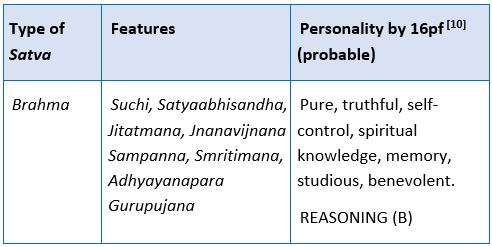Understanding the Relationship between Satva and Shareera w.s.r. to Personality Traits
DOI:
https://doi.org/10.21760/jaims.9.10.15Keywords:
Satva, Rajas, Tamas, Shareera, personality traitAbstract
Satva, Atma, Shareera are the three components. By the conjunction of these, existence of the living world is sustained. Understanding the relationship between these three components can help individual achieve a balanced and healthy life. Satva is one among the three innate qualities of the mind which governs psychosomatic manifestations and represents purity, virtue and enlightenment, while Rajas and Tamas denote passion /activity and inertia /ignorance respectively. Shareera on the other hand is a manifestation of Tridoshas (Vata, Pitta, Kapha). The relationship between Satva and Shareera is complex mechanism influencing each other in profound ways. Our thoughts and emotions generated by Satva can have direct impact and physical being. The body is influenced by the qualities of mind, and the mind is also shaped by the qualities of physical body. Personality traits are commonly defined as relatively stable pattern of thoughts, feelings and actions in which individual is different from the others. It is often seen as reflection of interplay between Satva and Shareera. Our innate characteristics are shaped by combination of genetic, environmental and personal experiences. These traits influence how we perceive ourselves and others as well as how we interact with world around us.
Downloads
References
Agnivesha. Charaka Samhita. Yadavji Trikamji Acharya editor. Varanasi: Chaukhamba Orientalia; 2020; reprint ed. page no.8.
Agnivesha. Charaka Samhita. Yadavji Trikamji Acharya editor. Varanasi: Chaukhamba Orientalia; 2020; reprint ed. page no.323.
Shastri Ambikadatt, Sushrut Samhita, edited with Ayurved Tatva Sandipika Hindi commentary, Shareera Sthana 4th chapter, Garba Vyakarana Shareera, Chaukhambha Sanskrit Sansthan; Varanasi: reprint edition; 2013; page no.37.
K.D.Mahapatra, Comparative Study of Ayurveda Psychiatry with Modern Science, The mind, Chaukhamba Orientalia;2012; page no.124.
Agnivesha. Charaka Samhita. Yadavji Trikamji Acharya editor. Varanasi: Chaukhamba Orientalia; 2020; reprint ed. page no.277.
Shreevathsa, Rambabu Dwivedi, Manasa Prakriti (Personality in Ayurveda), Concept of Manasa Prakrti: 1st ed; 2011; page no.119-120.
Agnivesha. Charaka Samhita. Yadavji Trikamji Acharya editor. Varanasi: Chaukhamba Orientalia; 2020; reprint ed. page no.323.
P.V.Tewari (Ed.), Kashyapa Samhita Vriddha Jivakiyatantra; Sutrasthana (1st ed.), Chaukhambha Vishwabharati Oriental Publishers, Varanasi (2008), Chapter 28, Lakshana Adhyaya Verse.10-19. Page no.81.
Shastri Ambikadatt, Sushrut Samhita, edited with Ayurved Tatva Sandipika Hindi commentary, Shareera Sthana 4th chapter, Garba Vyakarana Shareera, Chaukhambha Sanskrit Sansthan; Varanasi: reprint edition; 2013; page no.52.
K.D.Mahapatra, Comparative Study of Ayurveda Psychiatry with Modern Science, The Mind, Chaukhamba Orientalia;2012;page no.125-127.
Agnivesha. Charaka Samhita. Yadavji Trikamji Acharya editor. Varanasi: Chaukhamba Orientalia; 2020; reprint ed. page no.324-325.
P.V.Tewari (Ed.), Kashyapa Samhita vriddha jivakiyatantra; sutrasthana (1st ed.), Chaukhambha Vishwabharati Oriental Publishers, Varanasi (2008), Chapter 28, Lakshana Adhyaya Verse. 20-27, page no.84-85.
Shastri Ambikadatt, Sushrut Samhita, edited with Ayurved Tatva Sandipika Hindi commentary, Shareera Sthana 4th chapter, Garba Vyakarana Shareera, Chaukhambha Sanskrit Sansthan; Varanasi: reprint edition; 2013; page no.52.
Agnivesha. Charaka Samhita. Yadavji Trikamji Acharya editor. Varanasi: Chaukhamba Orientalia; 2020; reprint ed. page no.324.
Agnivesha. Charaka Samhita. Yadavji Trikamji Acharya editor. Varanasi: Chaukhamba Orientalia; 2020; reprint ed. page no.277.
Sharangadhara, Sharangadhara Samhita, Choukhambha Surbharti Prakashan, Varanasi, Reprint 2013, Purvakanda chapter 5, page no.75-76.















